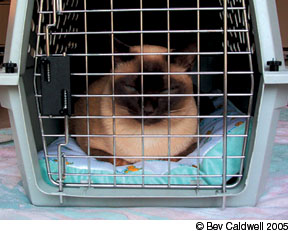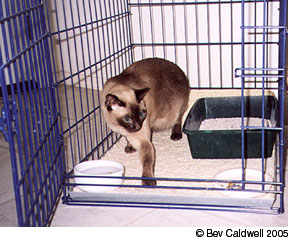Its that time again. You hoist the cat carrier from the top shelf of the closet and set it down on the living room floor. Before you can turn around, your cat races to squeeze under the nearest bed. Then comes the struggle to drag her out from her hiding place. Next comes the yowling and wrestling – until you finally squash your cat into the carrier and shut the door with an exhausted sigh of relief. You ask: Isnt there a better way? In most cases, there is. Heres some advice.

288
Prevent Trouble
Problems with the carrier usually start the first time you take your cat to the veterinarian or the groomer. Then every time afterwards, as soon as your pet sees the case, she associates it with something stressful. To break that association – or never start it in the first place – you must make the carrier seem neutral, like just another piece of furniture. Better yet, try to make it a pleasant place for your cat to visit.
Your best bet is to start when the cat is young, says Marie Heffron, owner of Four Paws Grooming center in Manlius, New York. Leave the carrier where the cat hangs out. Hell sniff it, walk around it and just get used to it being there.
The next step, says Heffron, is to leave the carrier open and let your cat go in and out on his own. Put some treats in the carrier, or favorite toys or a blanket your cat sleeps on. Who knows? Your cat may actually enjoy the carrier as another place to cuddle up for an afternoon nap.
Finally, allow your cat to go inside the carrier, and then close the door. Leave your cat inside and leave the room for about ten minutes. Then go back and let your cat out. This way your cat will get accustomed to the carrier functioning in different ways. Do this a couple of times a week to make it part of your cats routine.
Cat Versus Carrier
But chances are that your cat already hates the carrier and theres not much you can do about that. But you may be able to get him into the carrier with a little less trouble.
Remember this, says Heffron. If you miss getting your cat in the carrier the first time, your second try will only be harder. So try to get it done properly the first time around.
First, focus on securing your cat, then get the carrier. If you keep it in a remote location, be sure to have it handy – but out of your cats view – before you get started. Wrap your cat in a thick towel so that he cant claw you or grab onto the side of the carrier, says Heffron. After youve got your cat in the towel, then take out the carrier and slip the cat in – towel and all. Dont worry about the towel, says Heffron. Your cat will unfold herself from it once she is in the carrier.
When you drive with the carrier, the safer place is probably the back seat. If you put the carrier in the front seat, fasten the seatbelt around it for extra safety. You may find it helps to talk calmly to your cat while shes in the carrier, especially if your feline is in the front with you.

288
Some cats get sick on the way. I have one cat that vomits in his carrier every time he comes to my shop to get groomed, says Heffron. But its not the carrier; he just gets carsick. So we layer the bottom of the carrier with paper towels so its easier to clean on the way here and back home.
Pick Your Carrier Carefully
How do you choose a cat carrier among all the models that are available these days? First, consider what you will mostly use the carrier for, says Heffron. If you use it for short trips to the veterinarian or groomer, a plain, basic carrier will do fine. If you plan on taking your cat with you for longer trips, then its worth spending money on a carrier that is larger and more padded and comfortable.
Keep in mind that the carrier should be no more than one and a half times the size of your cat. You dont want the cat to have so much room that she slides back and forth as you carry the case. However, there should be enough room for your cat to lie down flat, stand up straight and turn around.
According to the Feline Behavior Guidelines from the American Association of Feline Practitioners (www.aafponline.org/resources/guidelines/Feline_Behavior_Guidelines.pdf), carriers that have both a top and a front opening are best. Removing the top makes it easier for you to get your cat out, and may permit your veterinarian to examine your cat without completely removing him from the carrier. Remember to pick your cat up carefully from a carrier. Never just dump him out.
Before you buy the carrier, check to see that there are no sharp parts that could harm your cat. Carefully examine the latches to see that they are secure. And what about looking out of the carrier? Some cats do fine while watching whats going on outside the carrier, says Heffron. With others, the less they can see out, the less stressful it is for them.
Luxury Carriers
If youre looking for something more spiffy than the usual hard-sided or cardboard carrier for your feline, you have some nifty options to choose from. Check on the Internet or at a pet supply shop for these items.
Bed/Carrier: This is a combination bed/carrier made from a basket with a comfortable pillow nestled inside. Keep it around the house and your cat may make it her favorite lounging spot. When its time to go on a trip, just put a fitted screen over the basket and your cat is ready to go.
Cat Tote: Your cat will be in fashion inside a carrier that looks and functions like a tote bag. You open the tote at the top, slip your cat in, and then carry the tote by straps or handles just like any other tote bag. The sides are open so your cat can peek out.
Cat Backpacks and Frontpacks: If you have an adventurous cat that likes to accompany you on walks downtown or in the park or on errands, this lightweight carrier style may be just what you both need. You can bring your cat with you and leave your hands free. Some of the packs double as automobile safety devices so you can slip them off your back and onto the back seat.



